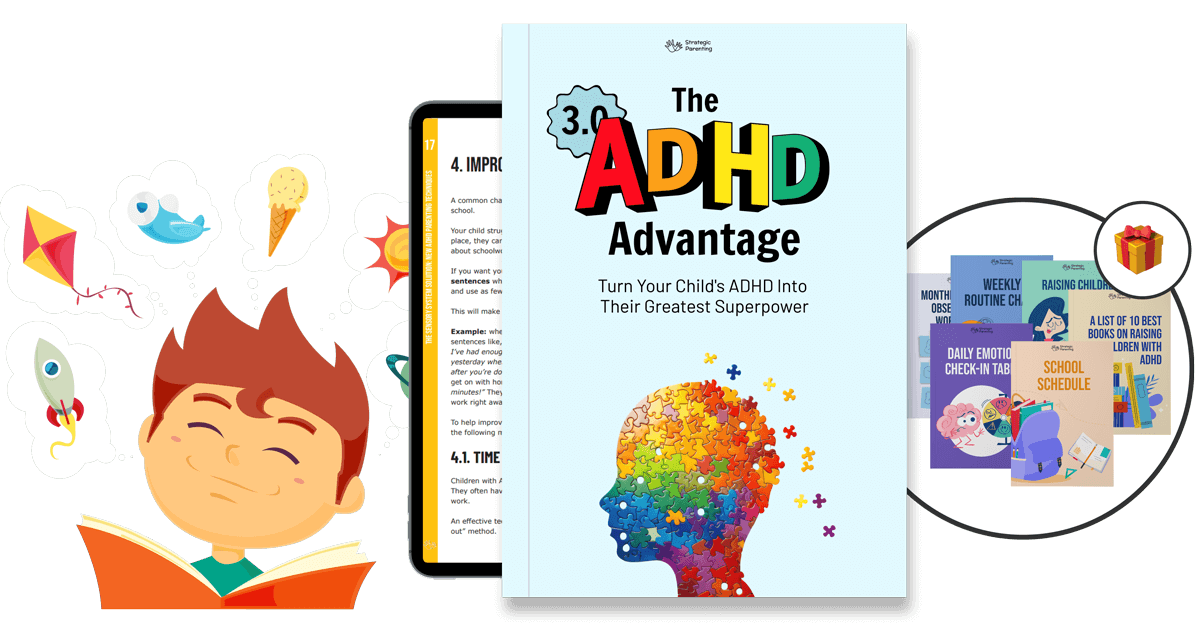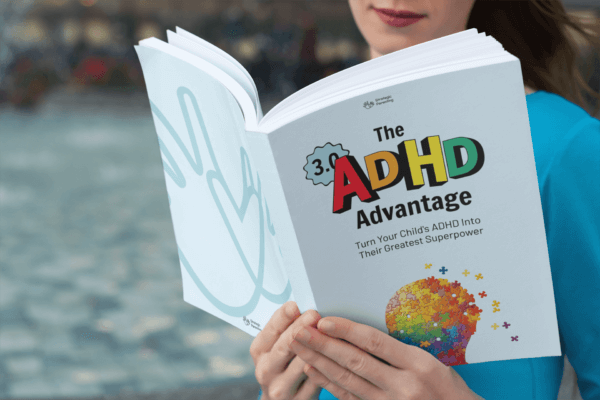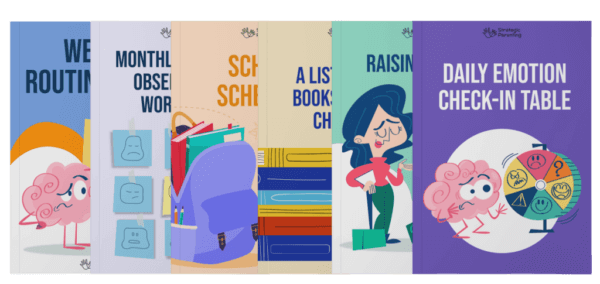Part 1: Your Child’s Unique Blueprint
First, I’ll walk you through the unique blueprint of your child’s ADHD brain so you can understand why and how they function differently than other kids.
This will help you tailor your parenting style to their own personal strengths, weaknesses and needs.
You will learn about:
- 3 Different Zones and how to help your child transition between focused work and creative activities without getting stuck in the Mental Traffic Jam
- Sensory Type: A step-by-step guide that will help you identify your child’s unique sensory type so you can tailor all the other 100+ strategies in the ebook to their specific needs
- 5 Tailored Physical Activities to train your child’s attention muscle and boost their focus
This introductory part will give you a strong foundation that will make everything else easier – from schoolwork to chores to keeping their attention and regulating their emotions – simply by better understanding your child.
Part 2: Boosting Self-Esteem & Confidence
Kids with ADHD have naturally lower self-esteem and confidence than others. After reading this part, you’ll fix that. You’ll teach your child how to believe in themselves, stand up for themselves, and not get stopped in their tracks by fear and anxiety.
You’ll learn about:
- Positive Discipline Strategies: You’ll be able to set healthy boundaries without “triggering a World War III”, to teach them what’s acceptable and what isn’t in a gentle, but firm way (and so they don’t use their ADHD as an excuse to not do the things they don’t want to do)
- Deep Connection Strategies: These will help you form an unbreakable bond with your child, based on mutual trust and respect, and bring you closer together than ever before
- Social Interactions: Help your child learn to express their needs calmly so they can speak up for themselves wherever they are – at home, school, playground, or anywhere else
- Tapping into Empathy: You’ll teach your kids how to become empathetic, active and respectful listeners that other kids enjoy hanging out with (rather than being unintentionally rude and speaking without thinking)
After implementing these strategies, you’ll set up your child for success. With their boosted confidence and self-esteem, they’ll believe they are enough and perfect just the way they are.
Part 3: Emotional Regulation
Next, you’ll be able to teach your kids how to regulate their emotions so they don’t get frustrated and angry as easily any more.
In this part, you’ll learn:
- 6 Calm-Down Techniques: Your kids will be able to use these whenever they feel overwhelmed, anxious or frustrated to bring themselves back to a state of calm and focus
- Patience Training: You’ll be able to teach your kids how to become more patient (instead of wanting everything they want to happen right away)
- Temper Tamers: By following a 5-step framework, you’ll teach your child patience and self-control
These skills will help your kids integrate into the world that’s different than they are – and stay calm and collected at times when they would otherwise blow up.
Part 4: Impulsivity & Outburst Prevention
Kids with ADHD are known to have impulsive outbursts, but there are ways to minimize and even prevent those from happening.
In this part, you’ll learn:
- 6 Outburst Prevention Strategies: These will help you avoid 90% or more of impulsive outbursts that disrupt your days
- A Simple Outburst Neutralization Strategy: That will help you quickly “extinguish” the situation before it gets out of hand
- 3 Key Calm-Down Protocols: That will help your kids quickly calm down and refocus in the rare case they can’t regulate their emotions
These strategies will help you avoid many disagreements that damage the relationships between you and your kids, and will teach them how to become masters of their emotions.
Part 5: Unlocking Ultra-Productivity
Because their brain is faster than normal, your child has a unique ability to get the same amount of work done within hours that would take other kids days or even weeks…
…IF you can help them organize their minds and lives in a way where they can spend most of their time in their Hyperfocus State, instead of Mental Traffic Jams.
In this part, you will learn:
- 6 Ultra-Productivity Strategies: These will help your child unlock their full potential on a daily basis
- A Simple Strategy to Eliminate Distracting Thoughts: These are one of the key reasons why your child can’t focus – they’re preoccupied with all the different thoughts in their head that take their attention away from the task at hand.
- The Finisher Framework: They’ll learn how to actually finish every task or project they start (and you’ll be able to help and guide them in a way they’ll gladly accept), so they don’t jump from one task to another every few minutes once they get bored of it.
After you implement the strategies from this part, your kids will no longer resist and procrastinate boring and uncomfortable tasks, and be all over the place.
They’ll see the “big picture”, get the important stuff done, and make much faster progress on things that are important to both you and them.
Part 6: Tailored Schoolwork Strategies
Your child likely thrives at subjects they’re interested in school, while struggling with ones they don’t like or don’t find interesting. Well, that’s about to change.
In this part, you will learn:
- The #1 Mistake Parents of Kids With ADHD Make: That turns schoolwork into a never-ending battle (and how to easily avoid it with a simple shift).
- ADHD-Friendly Learning Strategies: Your kids will be able to use these to learn and remember more while studying considerably less. They’ll also learn how to activate the right sides of their brain when it comes to different challenges they face.
- How to Eliminate School Work Distractions: If your kids would rather do anything but study.. If their mind keeps racing all the time… If they’re constantly fidgety and going to the fridge… You’ll be able to change all of that and bring their focus back through a set of proven but counterintuitive strategies.
- How to Unlock Their Endless Motivation State: You’ll learn about 3 key strategies that you can use to reignite their motivation and keep their motivation levels high – no matter how boring or annoying the subject they’re trying to learn might be to them.
After implementing these strategies, your child will no longer struggle with schoolwork and feel stressed out and anxious about it. This will have a ripple effect on your family, as there will be one less thing to argue about, and a lot more time that you can all spend doing things you enjoy.
Part 7: HyperFocus Strategies
Now that you have the fundamentals down, the really fun part begins.
With the strategies from this chapter, you’ll learn how to engage your child’s “HyperDrive” (that allows spaceships in the movies to travel faster than the speed of light).
This means that they’ll be able to enter a distraction-free mode when they need to and get their schoolwork and chores done even faster.
Yes, the tasks that “should take only 5 minutes but end up taking 2 hours” will now actually take them the amount of time they need.
In this part, you’ll learn:
- 15 HyperFocus Strategies: You can use these to engage the HyperDrive mode of their brain and effortlessly enter their Focus Zone
- ADHD Screen Time Management Strategies: To shift your kids from screen into the “real world”, and stop them from craving screen time all the time
- Focus Amplifiers: You’ll be able to use these to gently bring your kids back from a distracted to a focused state within seconds, and help them stay focused for hours on end
After implementing the strategies from this part, your kids will be able to get the most out of their Ferrari Brain and drive it as confidently as race car drivers.
Part 8: Supercharging Habits & Routines
Kids with ADHD need a slightly different environment (their bedroom, studying space and overall home organization) in order to stay focused, not forget things, and avoid living in a mess.
In this part, you’ll learn about:
- Creating Habits & Routines that STICK: This will make schoolwork, chores, morning routines, bedtime routines, after school activities and hygiene run much smoother.
- Habit Integration Frameworks: So they don’t have to use up their willpower every day and make their responsibilities automatic and effortless (which will save you from nagging, battles and disagreements)
- Home Reorganization Strategies: With a few subtle changes in the rooms they spend the most time in, you’ll be able to prevent messy and cluttered spaces that get on your nerves and distract them from focusing.
- Daily Workflows: These will help you structure their days in optimal ways so they can function as best as possible (both for school days and weekends) in fun and engaging ways that easily integrate into their existing lifestyle.
Once you tailor habits and routines to your child’s specific needs, the daily tasks will run much smoother and they’ll be far less distracted and “fidgety” because of the predictable routines.
Part 9: The ADHD Independent Chores System
Chores that your child finds boring, monotone or uninteresting can become the bane of their (and your) existence.
Luckily, there’s a set of specific strategies that you can use to help your child complete their chores independently, specifically tailored to kids with ADHD.
In this part, you’ll learn:
- When Your Kids Should Absolutely NOT Do Their Chores: And a much better time when they’ll do them without resistance.
- How To Get Your Kids EXCITED To Do Their Chores: This framework works so well that your kids will race to do their chores ahead of their scheduled chore time and ask you if they can do them, without you ever having to remind them.
- A Protocol For Facing Chore Resistance: In the rare case that your kids might not want to do their chores, you’ll be able to use a gentle step-by-step system to get them done anyway, without a fight.
Once you’ve taken care of both chores and school-work, you’ll already make living with an ADHD child A LOT easier – as these key areas of their lives are triggers for the majority of the battles and power struggles you’ll experience.
Part 10: Thriving with ADHD
Finally, you’ll learn about systems, routines and habits you can create to help your child thrive rather than survive with ADHD.
You will learn about:
- The 11 Essential Needs of Kids With ADHD: By fulfilling these essential needs on a regular basis, your kids will be far less likely to lose their attention and motivation and get stuck in Mental Traffic Jams.
- FUEL Strategies To Keep Their “Ferrari Brain” Running Smoothly: With concrete examples, systems and step-by-step frameworks that you can implement right away.
- A Thriving With ADHD Checklist: You can use this checklist every time your child is struggling or unfocused to quickly identify the root cause of their problem and choose the right FUEL Strategy in the right moment.
This part of the system is a cherry on top of the cake. It will supercharge every other part of the system you apply – from schoolwork to chores to keeping their attention and regulating their emotions.
BONUS Templates, Checklists & Printables
I know that I cover A LOT in this ebook – at over 170 pages, it’s quite comprehensive.
To make it easy and quick for you to implement the strategies you’ll learn in the ebook in your own life, I designed a variety of templates, checklists and printables that you can use to create bulletproof systems and routines in your child’s life.
I created templates for Schoolwork Routines, Chore Charts, checklists for Bedtime and Morning Routines, and so much more.
You’ll get some of these directly in the ebook, and others will be delivered to you together with the ebook in separate PDFs.
In the ADHD Advantage 3.0, I really thought of everything – and I know you’ll find these strategies as valuable as I did when it came to managing my own ADHD.

















